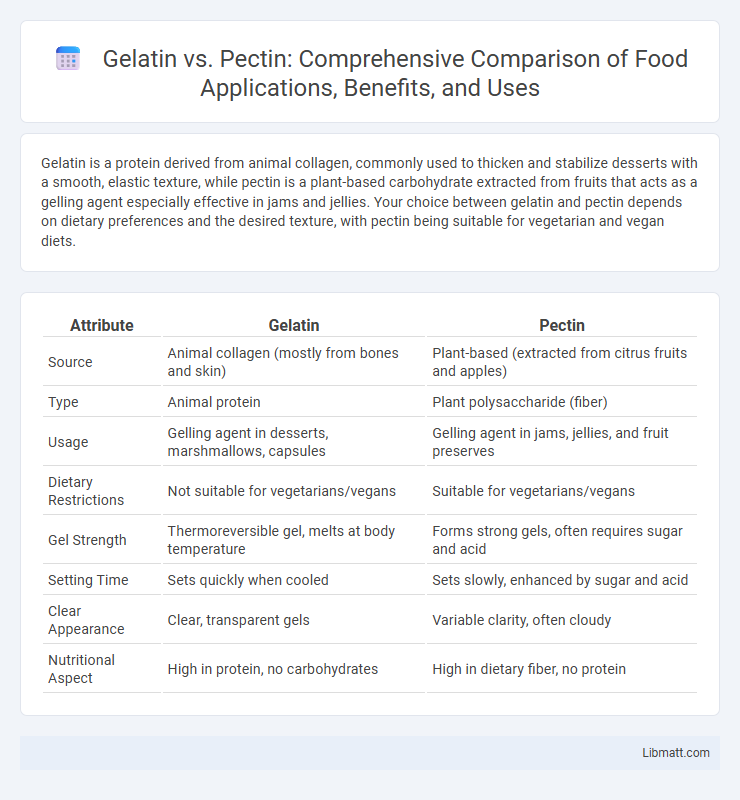Gelatin is a protein derived from animal collagen, commonly used to thicken and stabilize desserts with a smooth, elastic texture, while pectin is a plant-based carbohydrate extracted from fruits that acts as a gelling agent especially effective in jams and jellies. Your choice between gelatin and pectin depends on dietary preferences and the desired texture, with pectin being suitable for vegetarian and vegan diets.
Table of Comparison
| Attribute | Gelatin | Pectin |
|---|---|---|
| Source | Animal collagen (mostly from bones and skin) | Plant-based (extracted from citrus fruits and apples) |
| Type | Animal protein | Plant polysaccharide (fiber) |
| Usage | Gelling agent in desserts, marshmallows, capsules | Gelling agent in jams, jellies, and fruit preserves |
| Dietary Restrictions | Not suitable for vegetarians/vegans | Suitable for vegetarians/vegans |
| Gel Strength | Thermoreversible gel, melts at body temperature | Forms strong gels, often requires sugar and acid |
| Setting Time | Sets quickly when cooled | Sets slowly, enhanced by sugar and acid |
| Clear Appearance | Clear, transparent gels | Variable clarity, often cloudy |
| Nutritional Aspect | High in protein, no carbohydrates | High in dietary fiber, no protein |
Understanding Gelatin and Pectin: Key Differences
Gelatin, a protein derived from animal collagen, provides a smooth, elastic texture and is commonly used for gelling in desserts and confectionery. Pectin, a plant-based polysaccharide found in fruits, acts as a natural thickener and stabilizer, especially effective in jams and jellies due to its ability to gel in the presence of sugar and acid. The key differences lie in their origin--animal versus plant--and their specific applications, with gelatin favored for creamy textures and pectin for fruit preserves.
Sources and Composition: Animal vs. Plant-Based
Gelatin is derived from animal collagen found in bones, skin, and connective tissues, primarily sourced from pigs and cows, and is rich in amino acids like glycine and proline. Pectin is a plant-based polysaccharide extracted from the cell walls of fruits such as apples, citrus fruits, and berries, composed mainly of galacturonic acid units. Your choice between gelatin and pectin depends on dietary preferences, including vegan or vegetarian options, and the specific gelling properties required for your culinary or industrial applications.
Culinary Uses: Where Gelatin and Pectin Shine
Gelatin excels in creating smooth, creamy textures in desserts like mousses, panna cotta, and gummy candies due to its animal-based protein structure. Pectin, a plant-derived fiber found in fruits, is ideal for setting jams, jellies, and fruit preserves, delivering a firm yet tender consistency. Understanding where gelatin and pectin shine allows you to choose the perfect gelling agent for your culinary creations.
Texture and Consistency in Foods
Gelatin creates a smooth, elastic texture with a firm yet tender gel consistency, ideal for mousse, marshmallows, and gummy candies. Pectin produces a firmer, slightly more brittle gel commonly used in jams and jellies, offering a spreadable but stable consistency. The choice between gelatin and pectin significantly impacts the mouthfeel and structural properties of the final food product.
Health Benefits and Nutritional Profiles
Gelatin provides a rich source of amino acids like glycine and proline, which support joint health, skin elasticity, and digestive function. Pectin, a soluble fiber found in fruits, promotes gut health by aiding digestion and regulating blood sugar levels. You can enhance your diet by selecting gelatin for protein intake and pectin for fiber and cholesterol management.
Dietary Restrictions and Lifestyle Considerations
Gelatin is derived from animal collagen, making it unsuitable for vegetarians, vegans, and those following kosher or halal diets. Pectin, a plant-based fiber extracted from fruits, caters to vegan, vegetarian, and kosher dietary restrictions, offering a suitable alternative in jams and desserts. Individuals with dietary restrictions prefer pectin for its plant origin, while gelatin remains popular in traditional recipes for its unique gelling properties.
Application Techniques in Cooking and Baking
Gelatin and pectin serve distinct roles in cooking and baking, with gelatin typically used for creating smooth, elastic textures in desserts like panna cotta and marshmallows through dissolution in warm liquids. Pectin is preferred for thickening jams, jellies, and fruit preserves by forming a gel when combined with sugar and acid during boiling. Your choice between these gelling agents depends on the desired texture and the specific recipe requirements, as gelatin provides a flexible gel, while pectin yields a firmer, fruit-based set.
Shelf Life and Storage Comparisons
Gelatin typically has a shelf life of about 1 to 2 years when stored in a cool, dry place, while pectin often remains stable for up to 2 years if kept sealed and away from moisture. Both ingredients require airtight containers to prevent moisture absorption that can degrade their gelling properties. Proper storage significantly affects the longevity and effectiveness of gelatin and pectin in culinary applications.
Flavor Impact and Visual Appeal
Gelatin provides a smooth, melt-in-the-mouth texture that enhances the subtle flavors of desserts without overpowering them, while pectin offers a firmer, more structured gel that can slightly mute flavor intensity but adds a fresh, fruity note. Visually, gelatin creates a clear, glossy finish that makes your desserts look elegant and inviting, whereas pectin produces a more opaque, matte appearance that emphasizes a natural, wholesome aesthetic. Choosing between gelatin and pectin will affect the flavor profile and presentation of your dish, making it important to consider your desired sensory experience.
Choosing the Right Thickener for Your Recipe
Gelatin, derived from animal collagen, provides a smooth, elastic texture ideal for desserts like mousses and panna cotta, while pectin, a plant-based fiber from fruits, offers a firm gel perfect for jams and jellies. Your choice depends on dietary preferences and the desired consistency; gelatin melts when heated and sets upon cooling, whereas pectin requires sugar and acid to activate its gelling properties. Understanding these functional differences ensures your recipe achieves the perfect thickness and mouthfeel.
Gelatin vs Pectin Infographic

 libmatt.com
libmatt.com